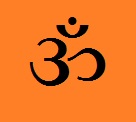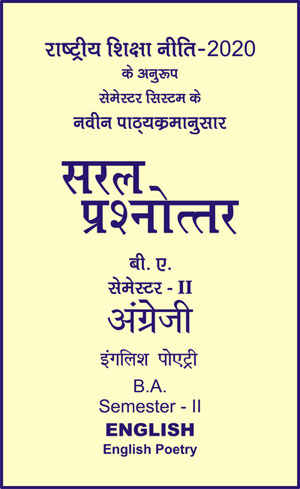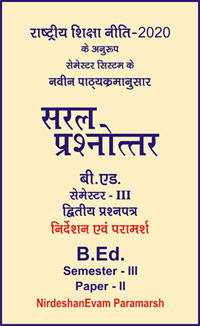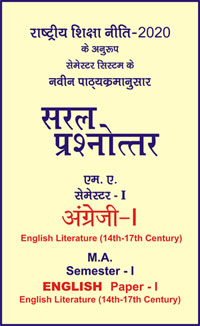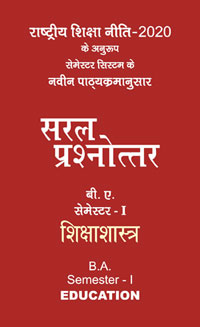|
बी ए - एम ए >> बीए सेमेस्टर-2 - अंग्रेजी - इंगलिश पोएट्री बीए सेमेस्टर-2 - अंग्रेजी - इंगलिश पोएट्रीसरल प्रश्नोत्तर समूह
|
|
|||||||
बीए सेमेस्टर-2 - अंग्रेजी - इंगलिश पोएट्री
Objective Type Questions
For each of the following questions four alternatives are given for the answer. Only one of them is correct. Choose the correct alternative:
1. What kind of poetry is sonnet?
(a) Subjective
(b) Objective
(c) Possessive
(d) None of these
2. Sonnet is a kind of....
(a) elegy
(b) ballad
(c) lyric
(d) ode
3. Sonnet has a .... structure.
(a) flexible
(b) fixed
(c) rigid
(d) soft
4. Sonnets are of...... kinds.
(a) four
(b) three
(c) one
(d) two
5. What is the rhyming arrangement that was introduced by Spenser?
(a) ab ab, be be, cd cd, ee
(b) abab, eded, efef, gg
(c) abba abba, cde cde
(d) None of these
6. The rhyming scheme that was introduced by William Shakespeare was ........
(a) abba abba, cde cde
(b) aaba aaba, cde cde
(c) abab, cdcd, efef, gg
(d) None of these
7. Shakespearean sonnet consists of ........... quatrains.
(a) one
(b) three
(c) two
(d) four
8. The Italian sonnet has the rhyming scheme...............'.
(a) abba abba cde, cde
(b) abab, cdcd, efef, gg
(c) aaba aaba cde, cde
(d) None of these
9. In English sonnet, the last two lines are
(a) heroic couplet
(b) tercet
(c) octave
(d) rhyming couplet
10. Who produced the Italian sonnet?
(a) Shakespeare
(b) Petrarch
(c) Spenser
(d) Wordsworth
11. How many lines are in the sonnet? The sonne is a poem of:
(a) 12
(b) 13
(c) 14
(d) 16
12. Petrarchan sonnet is divided into...... and .......
(a) octave, sestet
(b) quatrain, couplet
(c) tercet, couplet
(d) sestet, tercet
13. Octave is of............. lines.
(a) 12
(b) 10
(c) 6
(d) 8
14. Sestet is of..... lines.
(a) 8
(b) 6
(c) 4
(d) 2
15. Tercet is of.......lines.
(a) 2
(b) 4
(c) 3
(d) 5
16. To whom did Petrarch write his very first sonnet?
(a) His Wife
(b) His Friend
(c) His Son
(d) His Daughter
17. Elegy is specially ......for the dead.
(a) a parting song
(b) a happy song
(c) a lament
(d) a surprise
18. Sicilian Greeks produced the...... Elegy.
(a) general
(b) pastoral
(c) personal
(d) None of these
19. In the ............ Elegy, the poet expresses his sorrow in the guise of a shepherd mourning for another fellow-shepherd.
(a) pastoral
(b) personal
(c) general
(d) None of these
20. Personal Elegy expresses the ....... sorrow of the poet.
(a) general
(b) someone else's
(c) personal
(d) None of these
21. General Elegy expresses the suffering of ............. in general.
(a) person
(b) humanity
(c) dear to the poet
(d) None of these
22. Which elegy is written by Milton?
(a) Elegy written in a Country Churchyard.
(b) Thyrsis
(c) Rugby Chapel
(d) Lycidas
23. In ancient Greece, Ode was a poem to be sung by .......
(a) chorus
(b) a singer
(c) two singers
(d) None of these
24 How is the structure of Ode?
(a) Flexible
(b) Rigid
(c) Soft
(d) Hard
25. How many movements did an Ode contain?
(a) Two
(b) One
(c) Three
(d) Four
26. Ode was accompanied with
(a) dance
(b) story
(c) myth
(d) folk song
27. What are the movements of an Ode?
(a) Octave, Sestet
(b) Strophe, Anti-Strophe, Epode
(c) Quatrain, Rhyming Couplet
(d) Tercet, Sestet
28. Who produced the Pindaric Ode?
(a) Shakespeare
(b) Milton
(c) Wordsworth
(d) Pindar
29. "The Bard" is .......
(a) Pindaric Ode
(b) English Sonnet
(c) Miltonic Sonnet
(d) Lyric
30. The Classical Ode was of ...... types.
(a) two
(b) three
(c) four
(d) five
31. The Personal Ode and the Choral Ode was the example of .........
(a) personal and general
(b) self and general
(c) personal and Choral
(d) None of these
32. The Choral Ode is generally called ........
(a) The Horation
(b) The Regular
(c) The Irregular
(d) The Pindaric
33. There are............. kinds of Odes.
(a) three
(b) four
(c) two
(d) five
34. Who produced the Horation Ode?
(a) Pindar
(b) Horace
(c) Keats
(d) Yeats
35. In Horation Ode, the number of lines is ...... in each and every stanza of the whole ode.
(a) same
(b) different
(c) separate
(d) None of these
36. Keat's "Ode to The Nightingale" is the example of ........
(a) Horation Ode
(b) Irregular Ode
(c) Regular Ode
(d) Pindaric Ode
37. The Ode is ........ than lyric.
(a) shorter
(b) more emotional
(c) more logical
(d) longer
38. Sometimes Ode is personal or ....... in its nature.
(a) objective
(b) subjective
(c) collective
(d) emotional
39. Epic is a .......poem.
(a) long narrative
(b) short narrative
(c) medium narrative
(d) None of these
40. Epic deals with the....... figure.
(a) cartoon
(b) mean
(c) heroic
(d) knave
41. Epic is written is an ....... style.
(a) low
(b) cheap
(c) english
(d) elevated
42. Milton's "Paradise Lost" is an .......
(a) epic
(b) elegy
(c) english sonnet
(d) None of these
43. There are ........ kinds of Epic poetry.
(a) one
(b) two
(c) three
(d) four.
44. Pope's "The Rape of The Lock' is ........
(a) Epic Proper
(b) Mock-Epic
(c) Authentic Epic
(d) Literary Epic
45. What is the Literary Epic?
(a) Epic of Art
(b) Epic of Growth
(c) Epic Proper
(d) None of these
46. Epic is written in ....... metre.
(a) four
(b) three
(c) two
(d) one
47. The Epic dates from the .......... times.
(a) modern
(b) medieval
(c) present time
(d) None of these
48. The Epic has its roots deep in
(a) antiquity
(b) modern
(c) ancient
(d) None of these
49. The Epic contains a number of thrilling........
(a) scenes
(b) acts
(c) parts
(d) episodes
50. A........ is a parody of serious form of epic.
(a) Authentic Epic
(b) Literary Epic
(c) Mock-Epic
(d) None of these
51. In Mock-Epic, heroic tradition is.........
(a) praised
(b) ridiculed
(c) awarded
(d) admired
52. The Epic has a .......... structure.
(a) unique
(b) normal
(c) simpler
(d) complicated
53. The fifteenth century was the golden age of the.........
(a) Epic
(b) Lyric
(c) Ode
(d) Ballad
54. Ballads usually deal with........ and.......
(a) knights, ladies
(b) kings, queens
(c) lovers, beloveds
(d) friends, enemies
55. Keat's La Belle Dame Sans Merci' is...........
(a) Ode
(b) Lyric
(c) Ballad
(d) Elegy
56. Many literary ballads take the form of .........
(a) songs
(b) parodies
(c) myths
(d) None of these
57. Ballad is a term often loosely used of ............ song in general.
(a) folk.
(b) love
(c) sad
(d) native
58. In the modern sense, 'ballad' is a simple spirited poem in short stanzas in which some popular........... is graphically narrated.
(a) song
(b) music
(c) story
(d) None of these
59. Like the epic, the ballad arises out of.......... literature.
(a) folk
(b) village
(c) town
(d) city
60. The word 'Ballad' is derived from the ........ word 'ballar.
(a) English
(b) Egyptian
(c) Indian
(d) French
61. 'Ballar' means to ........
(a) sing
(b) dance
(c) tell
(d) cry
62. Ballad is............. in treatment.
(a) impersonal
(b) personal
(c) general
(d) None of these
63. Originally, lyric poetry was a composition to be sung with a.....
(a) Tabor
(b) Guitar
(c) Lyre
(d) Key-board
64. Lyric is essentially............. in character.
(a) subjective
(b) objective
(c) nominative
(d) None of these
65. How many thought or emotion does it embody?
(a) Four
(b) Three
(c) Two
(d) One
66. Is a lyric musical in character?
(a) No
(b) Yes
(c) Don't know
(d) None of these
67. Lyric is the cry of the heart of the .......
(a) friend
(b) public
(c) poet
(d) chorus
68. The thought or emotion in a lyric is .......
(a) simple
(b) complicated
(c) rigid
(d) None of these
69. What is My Last Duchess'?
(a) Dramatic Monologue
(b) Sonnet
(c) Lyric
(d) Ode
70. What is Dramatic Monologue?
(a) A poem
(b) A story
(c) A speech
(d) A song
71. The dramatic monologue is a poem with a ...... quality.
(a) human
(b) dramatic
(c) pictorial
(d) living
72. Does the listener of dramatic monologue speak?
(a) No
(b) Yes
(c) Don't know
(d) None of these
73. Allegory is a long ....... either in prose or in poetry.
(a) poem
(b) drama
(c) song
(d) story
74. Is the 'Faerie Queene' an allegory?
(a) No
(b) Yes
(c) Don't know
(d) None of these
75. Pope's 'An Epistle to Dr. Arbuthnot' is ........
(a) sonnet
(b) lyric
(c) drama
(d) allegory
76. In whose hands was the sonnet originally produced?
(a) Petrarch
(b) Milton
(c) Shakespeare
(d) Surrey
77. Which country did Petrarch belong to?
(a) England
(b) America
(c) France
(d) Italy
78. Petrarch was the Italian poet of ....... century.
(a) 13th
(b) 14th
(c) 15th
(d) 16th
79. From which language is the word 'Sonnet' derived?
(a) English
(b) Hebrew
(c) Italian
(d) None of these
80. Who was the first poet that used this form of poetry 'Sonnet'?
(a) Milton
(b) Petrarch
(c) Shakespeare
(d) Keats
81. Whom did Petrarch address in his first sonnet?
(a) Caroline
(b) Dorothy
(c) Raina
(d) Laura
82. Into how many parts is sonnet divided?
(a) Three
(b) Five
(c) Two
(d) Four
83. What is the rhyming scheme of octave?
(a) abba, abba
(b) abab, abab
(c) cde, cde
(d) abcd, abcd
84. What is the rhyming scheme of sestet?
(a) aab, aab
(b) cde, cde
(c) cdd, cdd
(d) None of these
85. The sestet is divided into two........
(a) octave
(b) quatrain
(c) couplet
(d) tercet
86. How many lines have a tercet?
(a) Five
(b) Four
(c) Three
(d) Two
87. How many syllables are there in a line of sonnet?
(a) Seven
(b) Eight
(c) Eleven
(d) Ten
88. Milton followed....
(a) Petrarchan Model
(b) Tom Model
(c) Shakespeare Model
(d) None of these
89. Who had introduced the Italian form in England?
(a) Wyatt
(b) Milton
(c) Chaucer
(d) Shakespeare
90. Who introduced the rhyming arrangement of "ab ab, bc bc, cd cd, ee" is English sonnet?
(a) Milton
(b) Shakespeare
(c) Spenser
(d) Larkin.
91. What was the rhyming scheme of Shakespearean sonnet?
(a) ab ab, bc bc, cd cd, ee
(b) abab, cdcd, efef, gg
(c) abba, abba, cde, cde
(d) None of these
92. How many lines are there in a quatrain?
(a) Six
(b) Seven
(c) Five
(d) Four
93. How many lines are there in a couplet?
(a) Two
(b) Four
(c) Six
(d) Eight
94. How many quatrains are there in a Shakespearean sonnet?
(a) Two
(b) Three
(c) Four
(d) Five
95. An Elegy is specifically a lament for the ..........
(a) lovers
(b) enemies
(c) the dead
(d) None of these
96. Which type of elegy is known as the pastoral elegy?
(a) Victorian
(b) Personal
(c) General
(d) Classic
97. Matthew Arnold's Rugby Chapel' expresses his personal grief on the death of his......
(a) mother
(b) father
(c) wife
(d) daughter
98. What shape has the present elegy taken?
(a) Memorial Elegy
(b) Personal Elegy
(c) General Elegy
(d) None of these
99. What kind of Gray's 'An Elegy Written in a Country Churchyard' is?
(a) General Elegy
(b) Personal Elegy
(c) Memorial Elegy
(d) All of these
100. Thomas Gray's 'Ode on the Death of a Favourite Cat' is a .........
(a) General Elegy
(b) Mock-Elegy
(c) Personal Elegy
(d) None of these
101. In which year was Gray's 'Ode on the Death of a Favourite Cat' published?
(a) 1648
(b) 1749
(c) 1748
(d) 1750
102. The best elegy is one in which the poet turns from personal sorrow to the ........ sorrow of mankind.
(a) general
(b) love
(c) hatred
(d) None of these
103. Ode was accompanied with
(a) music
(b) story
(c) myth
(d) dance
104. When Ode was sung, singer moved to one side during the .......... -
(a) epode
(b) anti-strophe
(c) strophe
(d) None of these
105. When Ode was sung, singer moved to backwards during the .........
(a) epode
(b) anti-strophe
(c) strophe
(d) None of these
106. When Ode was sung, singer stood still during the ........
(a) epode
(b) anti-Strophe
(c) strophe
(d) None of these
107. Three movements-strophe, anti-strophe and the epode was found in ..........
(a) Horation Ode
(b) Pindaric Ode
(c) Regular Ode
(d) Irregular Ode
108. Who was Pindar?
(a) Merchant
(b) Playwright
(c) Greek-poet
(d) None of these
109. Where had Pindaric Ode been originated?
(a) Greece
(b) Egypt
(c) England
(d) None of these
110. Some structural scheme in the arrangement of the stanzas are known as the .......... Odes.
(a) Horation
(b) Regular
(c) Pindaric
(d) None of these
111. 'Ode to the Nightingale' of John Keats is ............. Ode.
(a) Horation
(b) Pindaric
(c) Irregular
(d) Regular
112. Ode on the Intimation of Immortality' of Wordsworth is .........
(a) Irregular Ode
(b) Regular Ode
(c) Pindaric Ode
(d) Horation Ode
113. Which deals with the heroic figures?
(a) Lyric
(b) Sonnet
(c) Elegy
(d) Epic
114. Homer's 'Iliad' is .......
(a) ballad
(b) play
(c) epic
(d) None of these
115. To which stature do the characters of epic belong?
(a) Common
(b) Heroic
(c) Ordinary
(d) None of these
116. What is the treatment of the subject in an epic?
(a) Objective
(b) Subjective
(c) Possessive
(d) None of these
117. Which is not an epic?
(a) Iliad
(b) Odyssey.
(c) Paradise Lost
(d) All of these
118. Which is regarded as the most organized and systematic poetic creation?
(a) Epic
(b) Elegy
(c) Sonnet
(d) Lyric
119. How many kinds of Epic poetry are there in the world.
(a) One
(b) Two
(c) Three
(d) Four
120. A Mock-Epic is a ........ of serious form of Epic.
(a) humour
(b) parody
(c) satire
(d) None of these
121. The Epic often contains ........ machinery.
(a) hi-tech
(b) electric
(c) worthless
(d) super-natural
122. How many metres are generally used in an epic?
(a) One
(b) Two
(c) Three
(d) Four
123. Which field was fertile for the growth of Ballad?
(a) City
(b) Town
(c) Country
(d) None of these
124. Many literary ballads take the form of .......
(a) Movies
(b) Dramas
(c) Epics
(d) Parodies
125. Ballad is a song intended as the accompaniment to ..........
(a) dance
(b) love
(c) hate
(d) None of these
126. Ballad was the source of ........
(a) expressing
(b) earning
(c) telling
(d) None of these
127. Where does the ballad arise out?
(a) English literature
(b) German literature
(c) Folk literature
(d) None of these
128. What is the treatment of ballad?
(a) Personal
(b) Impersonal
(c) Classical
(d) Satirical
129. With which instrument was lyric sung?
(a) Lyre
(b) Guitar
(c) Key-board
(d) Piano
130. ........ is a rhythmic expression of a strong emotion.
(a) Sonnet
(b) Ballad
(c) Ode
(d) Lyric
131. Lyric springs up straight from the ........
(a) mind
(b) stomach
(c) heart
(d) kidney
132. What is musical in character?
(a) Sonnet
(b) Ode
(c) Elegy
(d) Lyric
133. In which poetic form are the audience silent?
(a) Lyric
(b) Dramatic Monologue
(c) Elegy
(d) Ballad
134. Dramatic monologue is ....... poetry.
(a) narrative
(b) subjective
(c) objective
(d) None of these
135. Tennyson's 'Ulysses' is a .......
(a) sonnet
(b) elegy
(c) dramatic monologue
(d) drama
136. Whose dramatic monologues are considered to be the best in English literature?
(a) Tennyson's
(b) Eliot's
(c) Milton's
(d) Browning's
137. Does the listener of dramatic monologue speak?
(a) Yes
(b) No
(c) Don't know
(d) None of these
138. Allegory is a long ........ either in prose or in poetry.
(a) song
(b) verse
(c) story
(d) None of these
139. The allegory is a ....... satire.
(a) hidden
(b) open
(c) both
(d) None of these
140. Bunyan's Pilgrims Progress' is one of the best known ........
(a) simile
(b) metaphor
(c) terza Rima
(d) allegory
141. Allegory has a ....... meaning also.
(a) first
(b) second
(c) third
(d) fourth
142. From which language is the word 'Allegory' derived?
(a) French
(b) German
(c) Latin
(d) African
143. Alexander Pope's 'An Epistle to Dr. Arbuthnot' is an ..........
(a) elegy
(b) allegory
(c) epic
(d) None of these
144. Which form of poetry deals with the heroic figures?
(a) A lyric
(b) A sonnet
(c) An elegy
(d) An epic
145. What was the rhyming scheme of Shakespearean sonnet?
(A) abba abba cde cde
(b) abab cdcd efef gg
(c) aaba aaba cde cde
(d) None of these
146. Who was the first poet who used the form of poetry 'Sonnet'?
(a) Petrarch
(b) Shakespeare
(c) Milton
(d) Keats
147. Classical drama refers to the drama of -
(a) the ancient France and Italy
(b) the ancient Greeks and Romans
(c) the ancient Greeks and France
(d) the ancient France and Romans
148. Classical drama follows the rules of -
(a) Dramatic Monologue
(b) Dramatic Device
(c) Dramatic Composition
(d) All of these
149. One of the greatest tragedians Greek drama is -
(a) Sophocles
(b) Terence
(c) Plantus
(d) Aristophanes
150. Aristotle divided the plot of a tragedy into -
(a) Complex and Compound
(b) Simple and Complex
(c) Simple and Compound
(d) Simple and Compact
151. In classical tragedy the tragic effect is created
(a) artificial
(b) theatrical
(c) natural
(d) All of these
152. Greek tragedy began to stage in the-
(a) Fifth century
(b) Eighth century
(c) Third century
(d) Sixth century
153. "In a classical tragedy the ideal tragic hero stands midway between the two extremes. His misfortune is brought by some faul of his own. He falls because of miscalculation on his part. The ideal tragic hero is a highly placed individual. He must be a person who occupies position of lofty eminence in the society." Who defined about the tragedy of pity and fear?
(a) Shakespeare
(b) Aristotle
(c) Ben Jonson
(d) Marlowe
154. Comedy is an imitation of -
(a) Men fauly
(b) Men Worse
(c) Men jesture
(d) None of these
155. "The Feneral" is a -
(a) Classical Comedy
(b) Sentimental Comedy
(c) Realistic Comedy
(d) Expressionist Comedy
156. Sentimental comedy became very popular in the -
(a) 17th century
(b) 19th century
(c) 18th century
(d) 20th century
157. Blank verse is a -
(a) Metrical verse
(b) Unrhymed verse
(c) Rhymed verse
(d) Occasional verse
158. Heroic coupled was first used by-
(a) Donne
(b) Carew
(c) Pope
(d) Dryden
159. Blank verse was first used in English poetry by -
(a) Shakespeare
(b) Surrey
(c) Milton
(d) Spenser
160. Blank verse was first used in Drama by -
(a) Langland
(b) Marlowe
(c) Sackville and Norton
(d) Shakespeare
161. "Poetry is the sister of sorrow, every tear a verse and every heart a poem". Who wrote this definition of poetry?.
(a) Andre
(b) John Donne
(c) Lamborn
(d) Leigh Hunt
162. Who is called the poets' poet-
(a) Shakespeare
(b) Spenser
(c) Milton
(d) Chaucer
163. Who was the first poet to write poetry in English -
(a) Spenser
(b) John skelton
(c) Chaucer
(d) Langland
164. "Poetry consists in best thought put in best words in best order." Who Justs wrote this definition of poetry -
(a) Coleridge
(b) Mill
(c) Carlyle
(d) Johnson
165. The period of Elizabethan Age -
(a) 1517-1608
(b) 1400-1500
(c) 1340-1400
(d) 1578-1625
166. A lyric is a -
(a) Descriptive poem
(b) Objective poem
(c) Narrative poem
(d) Subjective poem
167. Ode can be divided into -
(a) Two heads
(b) Three heads
(c) Four heads
(d) Six heads
168. The period of the age of classicism -
(a) 1650-1740
(b) 1702-1770
(c) 1630-1688
(d) 1614-1660
169. The pre-romantic period -
(a) 1750-1780
(b) 1630-1750
(c) 1740-1760
(d) 1770-1798
170. The last child of Renaissance is -
(a) Spenser
(b) Shakespeare
(c) Milton
(d) Marlowe
171. Renaissance mean -
(a) Imitation of chaucerian stanza
(b) Preference of allegory
(c) Portrayal of christan way of life
(d) Revival way of learning
172. Metaphysical poetry abounds in -
(a) Proverbs and maxims
(b) Satirical presentation
(c) Far-fetched ideas
(d) Conventional ideas
173. Which one is not the feature of Romanticism?
(a) Subjectivity
(b) Objectivity
(c) Democratic Outlook
(d) Love of nature
174. "Poetry is the record of the best and the happiest moment of the happiest and the best minds." Who wrote this definition of poetry?
(a) Emerson
(b) Shelley
(c) Ruskin
(d) W-B. Yeats
175. Romantic poets were influenced by -
(a) The French Revolution
(b) Latin classics
(c) Urbanity and Wit
(d) Puritan Ideology
176. Pre-Raphaelite poets were called -
(a) Painter poets
(b) Classical poets
(c) Religious poet
(d) Romantic poet
177. The greatest satirist of the Noe-classical age is -
(a) Oliver Goldsmith
(b) Alexander Pope
(c) Samuel Butler
(d) John Dryden
178. "Adonais" has been written by -
(a) Milton
(b) Sidney
(c) Shelley
(d) Keats
179. The word 'Pindaric' has been derived from the name of -
(a) a great Latin poet
(b) a great Italic poet
(c) a great French poet
(d) a great Greek poet
180. How many kinds of ode in english literature-
(a) Five
(b) Four
(c) Three
(d) Six
181. Mock-Epic is a -
(a) a parody of serious form of epic
(b) a lament on the death of person
(c) singing, quite impersonale
(d) Compostion to be sung with a lyre
182. A lyric is an expression of -
(a) a conscious purpose of the poet
(b) an expression of the poet's personal thought.
(c) a folk song of the people.
(d) None the these
183. What is striking illustrations of English Renaissance -
(a) More's Utopia
(b) Shakespeare's Hamlet
(c) Ben Jonson's Every man in his humour
(d) None of these
184. In Dramatic Monologue how many characters are there?
(a) One
(b) Two
(c) Three
(d) Four
185. Dramatic Monologue provides opportunity:
(a) Self Defence
(b) Self Surrender
(c) Self Criticism
(d) Self Evaluation
186. Psychoanalysis of Character is possible in:
(a) Epic
(b) Lyric
(c) Sonnet
(d) Dramatic Monologue
187. Name of Robert Browning is associated with:
(a) Dramatic Monologue
(b) Epic
(c) Lyric
(d) Ode
188. Which of the following poems is not a dramatic monologue?
(a) Last Ride Together
(c) Lamia
(b) Men and Women
(d) Porphariya's Lover
189. Find out figure of speech in Wandering Bark :
(a) Alliteration.
(b) Simile
(c) Metaphor
(d) Personification
190. Blank verse contains:
(a) Three feets
(b) Four feets
(c) Five feets
(d) Six feets
191. Iambic pentametric lines are in
(a) Blank Verse
(b) Monologue
(c) Free Verse
(d) Verse Libera
192. Which of the following is not a quality of epic?
(a) Consistency of structure
(b) Narrative time
(c) Sublime subject
(d) Trivial subject
193. 'Illiad' is written by:
(a) Valmiki
(b) Shakespeare
(c) Milton
(d) Homer
194. Homer is a/an ....... poet.
(a) French
(b) Greek
(c) Roman
(d) English
195. Author of Mahabharata' is :
(a) Kalidas
(b) Bhavbhuti
(c) Vedvyas
(d) Valmiki
196. Milton wrote:
(a) Paradise Lost
(b) Illiad
(c) In Memoriam
(d) Odyssey
197. "Ballad" deals with :
(a) Local Legends
(b) Love and Marriage
(c) War
(d) National Pride
198. The Ballad 'Le Dame Sans Merci' is written by:
(a) P.B. Shelley
(b) William Blake
(c) John Keats
(d) Rossetti
199. 'Chevy Chase' is a/am:
(a) Lyric
(b) Ballad
(c) Allegory
(d) Song
200. Ballad Rime of Ancient Mariners' is written by :
(a) Coleridge
(b) Keats
(c) P.B. Shelley
(d) Chesterton
201. The word 'Sonnet' is derived from Italian word:
(a) Sonntt
(b) Sonetto
(c) Sona
(d) Sonoto
202. The first eight lines of sonnet are called :
(a) Octeev
(b) Octiva
(c) Octave
(d) None of these
203. Among the following poets is not a sonnet writer :
(a) Sidney
(b) Lyly
(c) Spencer
(d) Shakespeare
204. Sonnet sequence 'Aristophel and Steela' is written by:
(a) Sidney
(b) Spencer
(c) Drayton
(d) Shakespeare
205. Elegy is a :
(a) Happy song
(b) Nature song
(c) Death song
(d) None of these
206. Which of the following is a pastoral elegy?
(a) In Memoriam
(b) Lycidas
(c) O' Captain, My Captain
(d) In Memory of W.B. Yeats
207. Who wrote the poem "Elegy Written in a Country Churchyard"?
(a) Collins
(b) Shelley
(c) Robert Bridges
(d) Thomas Gray
208. In elegy the atmosphere is :
(a) Gloomy
(b) Joyful
(c) Aggressive
(d) Fantastical
209. Pindaric Odes are :
(a) Romantic Odes
(b) Metaphysical Odes
(c) Classical Odes
(d) None of these
210. How many stanzas are in Classical Ode?
(a) 7
(b) 8
(c) 9
(d) 10
211. Who wrote, 'Ode to Psyche'?
(a) Keats
(b) Shelley
(c) Wordsworth
(d) William Blake
212. Which of the following odes is written by Collins?
(a) Ode to Clouds
(b) Ode to West Wind
(c) Ode to Autumn
(d) Ode to Evening
213. The "Ode Progress of Poesy" is written by:
(a) Thomas Gray
(b) Thomas More
(c) Thomas Hardy
(d) William Wordsworth
214. The Classical Ode or the pindaric Ode is structured in three parts:
(a) Strophe, Antistrophe, Epode
(b) Epode, Strophe, Antistrophe
(c) Strophe, Epode, Aniststrophe
(d) Anitstrophe, Strophe, Epode
215. "Ode to the West Wind" has been written by:
(a) Johen Keats
(b) P. B. Shelley
(c) William Wordsworth
(d) Lord Alfred Tennyson
216. The best example of allegory is:
(a) Addiosn's "Public Credit"
(b) Bunyan's "Pilgrim's Progress"
(c) Spenser's "Faerie Queene"
(d) All of tha above
217. Blank verse is a poetic form written:
(a) On a blank page
(b) With blank feelings
(c) In iambic pentameter lines rhyming with each other
(d) In iambic pentameter lines unrhymed
218. Horatian Ode is also known as:
(a) The Dorian Ode
(b) The Irregular Ode
(c) The English Ode
(d) Lesbian Ode
219. Thomas Wyatt and Earl of Surrey are connected with:
(a) Sonnet
(b) Lyric
(c) Elegy
(d) None of these
220. The Pindaric Ode was first wirtten in:
(a) Italy
(b) Greece
(c) Germany
(d) France
221. The Pindaric Ode was further practised after some modifications by the Roman poet:
(a) Homer
(b) Virgil
(c) Horace
(d) Plato
222. Which of the following is an Anglo-Saxon epic?
(a) Illiad
(b) Odyssey
(c) Aeneid
(d) Beowulf
223. Which of the following is not a ballad?
(a) La Belle Dame Sans Merci
(b) Chery-Chase
(c) Christabel
(d) My Last Duchess
224. Which of the following has been defined as "Moment's Momentum
(a) An ode
(b) An elegy
(c) A lyric
(d) A ballad
225. An allegory is a :
(a) Narrative where more is meant than meets the ear
(b) Musical composition expressing a single emotion
(c) Long narraative poem of great magnitude
(d) Mourning song or a poem of Lamentation
226. Which of the following is a long narrative poem treating a grand theme in a grand manner?
(a) Ballad
(b) Sonnet
(c) Epic
(d) Allegory
227. What is heroic couplet?
(a) Two iambic pentameter lines rhymed together (b) Three iambic pentametre lines rhymed together (c) Four iambic pentametre lines rhymed together (d) None of these
228. Who was the first poet that used the heroic couplet in his writing?
(a) Shakespeare
(b) Tennyson
(c) Chaucer
(d) None of these
229. Who was the second writer, besides Chaucer, that used the heroic couplet in his writings?
(a) Robert Browning
(c) Wordsworth
(b) Edmund Fairfax
(d) W. H. Auden
230. How many syllables are there in a heroic couplet?
(a) Twelve
(b) Ten
(c) Eight
(d) Four
231. Heroic Couplet is called heroic because it was used in
(a) common poetry
(b) general poetry
(c) heroic poetry
(d) love poetry
232. What is the Blank Verse?
(a) Unrhymed Verse
(b) Rhymed Verse
(c) Metrical Verse
(d) None of these
233. Who is the undisputed master of blank verse?
(a) Tennyson
(b) Shakespeare
(c) Wordsworth
(d) Browning
234. How many lines are there in Terza Rima?
(a) Four
(b) Two
(c) One
(d) Three
235. What is the rhyming scheme of Terza Rima?
(a) aba, bcb, ded, efe
(b) abab, cdcd, efef, gg
(c) abba, abba, cde, cde
(d) None of these
236. The poem written in Terza Rima usually end with a ....... line.
(a) double
(b) triple
(c) single
(d) None of these
237. Who was the first poet that used Terza Rima in his writting?
(a) Chaucer
(b) Shakespeare
(c) Larkin
(d) Auden
238. Who was the first poet who used heroic couplet in his writings?
(a) Shakespeare
(b) Milton
(c) Chaucer
(d) None of these
239. Chaucer used heroic couplet in .......
(a) Hamlet
(b) Arms and the Man
(c) To the Pupils
(d) Canterbury Tales
240. Who was considered the next writer of heroic couplet?
(a) Edmund Fairfax
(b) Milton
(c) Dryden
(d) None of these
241. What presents Chaucer's first experiment in the heroic couplet?
(a) Canterbury Tales
(b) Nagasaki
(c) The Legend of Good Women
(d) None of these
242. How many syllables are there in a heroic couplet?
(a) Eight
(b) Nine
(c) Eleven
(d) Ten
243. Who was called a master and innovator in the field of heroic couplet?
(a) Chaucer
(b) Pope
(c) Shakespeare
(d) None of these
244. What is Blank verse?
(a) Unrhymed verse
(b) Rhymed verse
(c) Long verse
(d) Short verse
245. Who introduced the Blank verse into English?
(a) Thomas Wyatt
(b) Earl of Surrey
(c) Shouthey
(d) None of these
246. In which tragedy was the Blank verse first used?
(a) Gorboduc
(b) Othello
(c) To Milton
(d) None of these
247. Who is called the undisputed master of blank verse?
(a) Marlowe
(b) Milton
(c) Chaucer
(d) Shakespeare
248. Who invented the Spenserian stanza?
(a) Shakespeare
(b) Chaucer
(c) Spenser
(d) All of these
249. How many lines are there in a Spenserian stanza?
(a) Eight
(b) Nine
(c) Ten
(d) Twelve
250. How many lines does an Ottova Rima have?
(a) Eight
(b) Nine
(c) Ten
(d) Six
251. 'Rhyme Royal' contains .......
(a) Eight lines
(b) Nine lines
(c) Ten lines
(d) Seven lines
252. How many lines are there in a Ballad stanza?
(a) Seven
(b) Eight
(c) Nine
(d) Ten
253. The Terza Rima is a ............. line stanza.
(a) one
(b) two
(c) three
(d) four
254. A ..... rhyme pattern used in Terza Rima.
(a) long
(b) chain
(c) short
(d) None of these
255. In Heroic Couplet there are:
(a) Four lines
(b) Three lines
(c) Two lines
(d) One line
256. Spenserian stanza for the first time used by Spenser in .......
(a) Revolt Islam
(b) Divine Comedy
(c) Fairy Queen
(d) Eve of St. Aquinas
257. In Terza Rima, the stanza is of:
(a) Three lines
(b) Four lines
(c) Five lines
(d) Six lines
258. Tradition of Blank Verse in English poetry was introduced by:
(a) Marlowe
(b) Thomas Wyatt
(c) Phillip Sidney
(d) Shakespeare
259. A line with six feet is called :
(a) Pentameter
(b) Hexameter
(c) Heptameter
(d) Tetrameter
260. Into how many broad parts is the Pindaric Ode divided?
(a) Three parts
(b) Eight parts
(c) Six parts
(d) Four parts
261. ...........is made up of 7 iambic pentameter.
(a) Rhyme
(b) Quatrain
(c) Rhyme Royal
(d) None of the above
262. The word "Caesura" means:
(a) A pause
(b) Comparison
(c) Simile
(d) Anastrophe
263. .........refers to the pattern of long, stressed and unstressed syllables in writing.
(a) Rhythm
(b) Meter
(c) Structure
(d) Rhyme
264. Which is not a feature of Horatian Ode?
(a) Calm and contemplative tone
(b) Named after the poet, Horace
(c) Comes from Greek Origin
(d) Made up of around two quatrains
265. Monostich is :
(a) a one line stanza
(b) an entire poem
(c) a syllable
(d) both (a) and (b)
266. A poem that is free from the limitations of a regular meter or rhythm and also does not rhyme with fixed forms is called ....... poetry.
(a) Pastoral
(b) Free Verse
(c) Epic
(d) None of the above
267. At the end of the lines in a poem the similar sounding words are called :
(a) Meter
(b) Rhythm
(c) Rhyme
(d) Alliteration
268. A short traditional and popular story in verse of unknown authorship is called :
(a) Lyric
(b) Ballad
(c) Elegy
(d) Sonnet
269. The word 'satire' is derived from the ......
word lanx satura.
(a) Greek
(b) British
(c) Latin
(d) American
270. "O Attic Shape!". Identify the figure of speech used here:
(a) Personification
(b) Apostrophe
(c) Metaphor
(d) Oxymoron
271. Which is not a characteristic of a Ballad?
(a) It is a song that tells a story
(b) The beginning is often surprising
(c) The theme is often tragic and sad
(d) It is of various types such as personal, impersonal or pastoral
272. Inversion is also known as:
(a) Strophe
(b) Epode
(c) Anastrophe
(d) None of the above
273. When we use repetition of vowel sounds, it is known as:
(a) Euphemism
(b) Pun
(c) Anaphora
(d) Assonance
274. ......... is used to refer to a situation where the audience knows more about what's going on one-screen than the characters do..
(a) Verbal irony
(b) Situational irony
(c) Dramatic irony
(d) Non-verbal irony
275. A stanza of four lines of iambic pentameter, rhyming abab, could be described as a :
(a) Octave
(b) Quatrain
(c) Sestet
(d) Strophe
276. An epic is a poem :
(a) Written to praise a person, event or subject
(b) Long narrative poem concerning a serious subject
(c) A musical song
(d) A lament which expresses gloomy thoughts
277. Poetic Devices based on the sound of words include :
(a) Metaphor
(b) Irony
(c) Allusion
(d) Cacophony
278. How many English sonnets in all were written by Milton?
(a) 18
(b) 14
(c) 17
(d) 19
|
|||||
- Chapter - 1 Forms of Poetry & Stanza Forms
- Objective Type Questions
- Answers
- Chapter - 2 Poetic Device
- Objective Type Questions
- Answers
- Chapter - 3 "Let Me Not to the Marriage of True Minds" (Sonnet No. 116)
- Objective Type Questions
- Answers
- Chapter - 4 "On His Blindness"
- Objective Type Questions
- Answers
- Chapter - 5 "Present in Absence"
- Objective Type Questions
- Answers
- Chapter - 6 "Essay on Man”
- Objective Type Questions
- Answers
- Chapter - 7 "Elegy Written in a Country Churchyard”
- Objective Type Questions
- Answers
- Chapter - 8 "The World is Too Much with Us"
- Objective Type Questions
- Answers
- Chapter - 9 "Ode on a Grecian Urn"
- Objective Type Questions
- Answers
- Chapter - 10 "Break, Break, Break"
- Objective Type Questions
- Answers
- Chapter - 11 "How Do I Love Thee?"
- Objective Type Questions
- Answers
- Chapter - 12 "Dover Beach"
- Objective Type Questions
- Answers
- Chapter - 13 "My Last Duchess'
- Objective Type Questions
- Answers
- Chapter - 14 "The Love Song of J. Alfred Prufrock"
- Objective Type Questions
- Answers
- Chapter - 15 "The Lake Isle of Innisfree"
- Objective Type Questions
- Answers
- Chapter - 16 "Church Going"
- Objective Type Questions
- Answers
- Chapter - 17 Rhetoric and Prosody - Practical Criticism
- Objective Type Questions
- Answers

 i
i 
